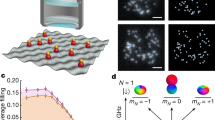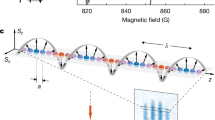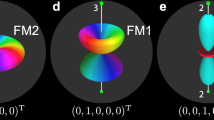Abstract
A rich variety of physical effects in spin dynamics arise at the interface between different magnetic materials1. Engineered systems with interlaced magnetic structures have been used to implement spin transistors, memories and other spintronic devices2,3. However, experiments in solid-state systems can be difficult to interpret because of disorder and losses. Here we realize analogues of magnetic junctions using a coherently coupled mixture of ultracold bosonic gases. The spatial inhomogeneity of the atomic gas makes the system change its behaviour from regions with oscillating magnetization—resembling a magnetic material in the presence of an external transverse field—to regions with a defined magnetization, similar to magnetic materials with ferromagnetic anisotropy stronger than external fields. Starting from a far-from-equilibrium fully polarized state, magnetic interfaces rapidly form. At the interfaces, we observe the formation of short-wavelength magnetic waves. They are generated by a quantum torque contribution to the spin current and produce strong spatial anticorrelations in the magnetization. Our results establish ultracold gases as a platform for the study of far-from-equilibrium spin dynamics in regimes that are not easily accessible in solid-state systems.
This is a preview of subscription content, access via your institution
Access options
Access Nature and 54 other Nature Portfolio journals
Get Nature+, our best-value online-access subscription
$29.99 / 30 days
cancel any time
Subscribe to this journal
Receive 12 print issues and online access
$209.00 per year
only $17.42 per issue
Buy this article
- Purchase on Springer Link
- Instant access to full article PDF
Prices may be subject to local taxes which are calculated during checkout




Similar content being viewed by others
Data availability
Source data are provided with this paper. The data that support the findings of this study are available from the corresponding authors upon reasonable request.
References
Zabel, H. & Bader, S. D. (eds) Magnetic Heterostructures: Advances and Perspectives in Spinstructures and Spintransport (Springer, 2007).
Wolf, S. A. et al. Spintronics: a spin-based electronics vision for the future. Science 294, 1488–1495 (2001).
Locatelli, N., Cros, V. & Grollier, J. Spin-torque building blocks. Nat. Mater. 13, 11–20 (2014).
Landau, L. & Lifshitz, E. On the theory of the dispersion of magnetic permeability in ferromagnetic bodies. Phys. Z. Sowjetunion 8, 153 (1935).
Bar'yakhtar, V. G. & Ivanov, B. A. The Landau-Lifshitz equation: 80 years of history, advances, and prospects. Low Temp. Phys. 41, 663 (2015).
Josephson, B. D. Possible new effects in superconductive tunnelling. Phys. Lett. 1, 251–253 (1962).
Smerzi, A., Fantoni, S., Giovanazzi, S. & Shenoy, S. R. Quantum coherent atomic tunneling between two trapped Bose-Einstein condensates. Phys. Rev. Lett. 79, 4950 (1997).
Nikuni, T. & Williams, J. E. Kinetic theory of a spin-1/2 Bose-condensed gas. J. Low Temp. Phys. 133, 323–375 (2003).
Pigneur, M. & Schmiedmayer, J. Analytical pendulum model for a bosonic Josephson junction. Phys. Rev. A 98, 063632 (2018).
Zibold, T., Nicklas, E., Gross, C. & Oberthaler, M. K. Classical bifurcation at the transition from Rabi to Josephson dynamics. Phys. Rev. Lett. 105, 204101 (2010).
Albiez, M. et al. Direct observation of tunneling and nonlinear self-trapping in a single bosonic Josephson junction. Phys. Rev. Lett. 95, 010402 (2005).
Matthews, M. R. et al. Watching a superfluid untwist itself: recurrence of Rabi oscillations in a Bose–Einstein condensate. Phys. Rev. Lett. 83, 3358 (1999).
Nicklas, E. et al. Rabi flopping induces spatial demixing dynamics. Phys. Rev. Lett. 107, 193001 (2011).
LeBlanc, L. J. et al. Dynamics of a tunable superfluid junction. Phys. Rev. Lett. 106, 025302 (2011).
Spagnolli, G. et al. Crossing over from attractive to repulsive interactions in a tunneling bosonic Josephson junction. Phys. Rev. Lett. 118, 230403 (2017).
Pigneur, M. et al. Relaxation to a phase-locked equilibrium state in a one-dimensional bosonic Josephson junction. Phys. Rev. Lett. 120, 173601 (2018).
Mennemann, J.-F. et al. Relaxation in an extended bosonic Josephson junction. Phys. Rev. Res. 3, 023197 (2021).
Luick, N. et al. An ideal Josephson junction in an ultracold two-dimensional Fermi gas. Science 369, 89–91 (2020).
Kwon, W. J. et al. Strongly correlated superfluid order parameters from d.c. Josephson supercurrents. Science 369, 84–88 (2020).
Pitaevskii, L. & Stringari, S. Bose–Einstein Condensation and Superfluidity (Oxford Univ. Press, 2016).
Kosevich, A., Ivanov, B. & Kovalev, A. Magnetic solitons. Phys. Rep. 194, 117–238 (1990).
Congy, T., Kamchatnov, A. M. & Pavloff, N. Dispersive hydrodynamics of nonlinear polarization waves in two-component Bose–Einstein condensates. SciPost Phys. 1, 006 (2016).
Ivanov, S. K., Kamchatnov, A. M., Congy, T. & Pavloff, N. Solution of the Riemann problem for polarization waves in a two-component Bose–Einstein condensate. Phys. Rev. E 96, 062202 (2017).
Chang, J. J., Engels, P. & Hoefer, M. A. Formation of dispersive shock waves by merging and splitting Bose–Einstein condensates. Phys. Rev. Lett. 101, 170404 (2008).
Mossman, M. E., Hoefer, M. A., Julien, K., Kevrekidis, P. G. & Engels, P. Dissipative shock waves generated by a quantum-mechanical piston. Nat. Commun. 9, 4665 (2018).
Mossman, M. E., Delikatny, E. S., Forbes, M. M. & Engels, P. Stability in turbulence: the interplay between shocks and vorticity in a superfluid with higher-order dispersion. Phys. Rev. A 102, 053310 (2020).
Daniel, M., Kruskal, M. D., Lakshmanan, M. & Nakamura, K. Singularity structure analysis of the continuum Heisenberg spin chain with anisotropy and transverse field: nonintegrability and chaos. J. Math. Phys. 33, 771 (1992).
Tsubota, M., Aoki, Y. & Fujimoto, K. Spin-glass-like behavior in the spin turbulence of spinor Bose–Einstein condensates. Phys. Rev. A 88, 061601 (2013).
Farolfi, A., Trypogeorgos, D., Mordini, C., Lamporesi, G. & Ferrari, G. Observation of magnetic solitons in two-component Bose–Einstein condensates. Phys. Rev. Lett. 125, 030401 (2020).
Farolfi, A. et al. Design and characterization of a compact magnetic shield for ultracold atomic gas experiments. Rev. Sci. Instrum. 90, 115114 (2019).
Knoop, S. et al. Feshbach spectroscopy and analysis of the interaction potentials of ultracold sodium. Phys. Rev. A 83, 042704 (2011).
Bienaimé, T. et al. Spin-dipole oscillation and polarizability of a binary Bose–Einstein condensate near the miscible-immiscible phase transition. Phys. Rev. A 94, 063652 (2016).
Fava, E. et al. Observation of spin superfluidity in a Bose gas mixture. Phys. Rev. Lett. 120, 170401 (2018).
Farolfi, A. et al. Manipulation of an elongated internal Josephson junction of bosonic atoms. Phys. Rev. A 104, 023326 (2021).
Acknowledgements
We thank F. Dalfovo for his critical reading of the manuscript and M. Oberthaler, G. Consolo, D. Go, E. Mendive-Tapia and N. Pavloff for fruitful discussions. We acknowledge funding from INFN through the FISH project, from the European Union’s Horizon 2020 Programme through the NAQUAS project of QuantERA ERA-NET Cofund in Quantum Technologies (grant agreement no. 731473) and from Provincia Autonoma di Trento. We thank the BEC Center, the Q@TN initiative and QuTiP.
Author information
Authors and Affiliations
Contributions
A. Recati and G.F. conceived the project. A.F. performed the experiment. A.F. and A.Z. analysed the experimental data. D.T. set up the experiment control. A.G., A. Recati and A. Roy developed the theory and performed the corresponding numerical simulations. A. Recati, A.Z. and G.L. wrote the manuscript. All the authors contributed to the discussion and interpretation of results.
Corresponding authors
Ethics declarations
Competing interests
The authors declare no competing interests.
Additional information
Peer review information Nature Physics thanks the anonymous reviewers for their contribution to the peer review of this work.
Publisher’s note Springer Nature remains neutral with regard to jurisdictional claims in published maps and institutional affiliations.
Extended data
Extended Data Fig. 1 Comparison between spin hydrodynamic (SH) and LLE simulation.
Total density relative modulation (a), modulus of the total current (b), magnetization (c) and modulus of the spin current (d) simulated according to the SH around the interface before and after its breaking. The magnetization resulting from LLE (e) shows a very good agreement, accordingly to the negligible role of the density modulation in the dynamics. f, Contribution of the spin current term related to the quantum torque. Also in this case, panel f shows that the second term in Eq. (2) dominates over the first one, hence the quantum torque drives the dynamics. The colorscale units of plots b,d,f is atoms/ms.
Source data
Source Data Fig. 2
Source data: {x,y,z} for Fig. 2c,d and {x,y} for Fig.2a,b,e,g and the insets.
Source Data Fig. 3
Source data: {x,y,z} for Fig. 3a,b and {x,y} for Fig. 3c–h.
Source Data Fig. 4
Source data: {x,y,z} for the insets and {x,y,dy} for Fig. 4a,b.
Source Data Extended Data Fig. 1
Source data: {x,y,z} for Extended Data Fig. 1.
Rights and permissions
About this article
Cite this article
Farolfi, A., Zenesini, A., Trypogeorgos, D. et al. Quantum-torque-induced breaking of magnetic interfaces in ultracold gases. Nat. Phys. 17, 1359–1363 (2021). https://doi.org/10.1038/s41567-021-01369-y
Received:
Accepted:
Published:
Issue Date:
DOI: https://doi.org/10.1038/s41567-021-01369-y



